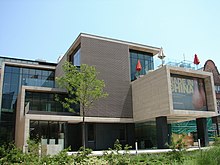Lamellar facade
As lamella facade in to architecture and construction all façade constructions refer to operations where a large area fins are used. The slats can consist of all possible building materials , wood , metal and glass are common . Materials such as ceramics or solar cells are also used. The slats can be fixed on a substructure or they can be movable. The slats are almost always arranged horizontally, but in rare cases also vertically ( vertical slats).
Opaque lamellae
Opaque ventilation slats
If external ventilation of certain interior spaces is desired ( e.g. building services rooms or parking garages ), opaque slats are used as a glare facade . Mostly they are narrow and made of painted aluminum sheet. The air can penetrate between the slats or be sucked in. However, nothing of the technical equipment can be seen, the facade has a flat appearance. If the suspension is movable, the air supply can be controlled.
External sun protection slats
Slats that are attached to a glass facade serve as sun protection . The facade has a closed, two-dimensional effect on the outside, but is semi-transparent on the inside. The effect is reversed at night. The slats shape the appearance of the facade and serve as an important design element. With a movable suspension, shading and privacy can be regulated by the user.
Decorative slats
Slats are also used purely as a design element in front of closed wall surfaces . They have no further technical function there and are only used for decorative purposes. These are often narrow slats made of wood or sheet metal.
Glass slats
Double facades
In the case of double facades (sometimes colloquially called second-skin facades ), movable glass slats are used to regulate the ventilation . If they are installed in the outer facade level, the ventilation of the space between the facade, which serves as a climate buffer, can be regulated. If they are integrated into the primary facade, they can be used to ventilate the interior .
Openable louvre glazing
Movable glass slats are also used in single-shell facades if, in addition to weather protection and high transparency, regulation of the building climate and compliance with fire protection requirements are required. Some manufacturers offer frameless and openable louvre glazing. The glass lamellas are attached to the outside of the facade mullions and mounted off-center on the upper edge. The glass slats , which are up to 4.5 meters long, but only have a load bearing capacity of 1.5 meters, can run over several grid units. This eccentric mounting means, however, a considerable increase in the costs for the drive, because in contrast to the central mounting as with louvre windows , the entire weight of the louvre must be lifted. The system was invented in 1983 by the engineer Arthur Klemt from Munich. It was first used in 1989 in an 85 meter long and 20 meter wide sales hall in Klagenfurt and in 1991 in the 50 × 50 meter pavilion of the Republic of Austria at the world exhibition EXPO '92 in Seville by the Austrian architect Volker Giencke .
See also
- Louvre windows for windows that have glass louvres instead of fixed glazing
- Blinds and lamellas for internal shading systems
Individual evidence
- ↑ History of the openable louvre glazing ( page no longer available , search in web archives ) Info: The link was automatically marked as defective. Please check the link according to the instructions and then remove this notice. , on the homepage of Glashaus KG

